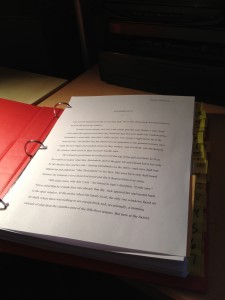It happened: I got the editorial letter for my children’s novel on Monday. It’s fifteen pages long (“we always give very extensive notes,” the editor warned me) and comes with a deadline in mid-January, a couple weeks after I have a column due and a week before I give a big lecture. And through it all I am working-full time, driving out of state for Christmas, and trying to keep up a fabulous lifestyle of staying mostly awake.
It’s not that I didn’t know the letter was coming. I handed in the first draft the Monday before Thanksgiving and then waved a turkey leg in the air to celebrate. Obviously some kind of tryptophan amnesia ensued, followed by jetlag and then a mild case of seasonal tinsel trance, because here I was sailing along Holidillydallying and feeling things were under control, until boop went the email and I remembered I have a novel to work on. A novel full of people with undeveloped emotional arcs! And now they are calling to me, their voices full of (unexplained) sadness, begging me to come back and give them terrible early childhoods and stuff.
But you know, I think I’ve got this. I have to keep remembering revision is one of the most bird-by-bird processes of writing. Some of the revisions amount to reworking several pages; others are a matter of adding a sentence or two, or changing a name. There are things I can do when I only have an hour free. When I was working on changes to The Wilder Life I figured out how to manage the workload using the magic of office supplies, and I’m doing it again with this project. And because I’m a dork, I’ll show you.

Here’s the hard copy of my first draft, stuck in a binder. I work onscreen, but it’s awfully handy to have the hard copy at my side, since the page numbers in my editor’s notes refer to this draft, and when I start making changes, things will shift. I added some stick-on index tabs that let me go straight to a chapter as well. It’s a little bit of a pain to set up, but it saves a lot of flipping around later.
My editorial letter includes a set of notes organized by chapter. I printed up those notes on some colored paper (goldenrod!) and then cut out each note or direction and taped it to the relevant page, usually near the paragraph in question. I tape the notes with Magic tape on the back of the page and then fold them over. It’s similar to the way we used to attach manuscript notes at my own editorial job, back before we were all using Track Changes in MS Word. If I really wanted to be old-school I could attach the notes with STRAIGHT PINS, which is what the old editions of Chicago Manual of Style say to do. HARDCORE.
It’s a little tedious doing all the cutting and taping, but since you’re being so hands-on with the manuscript, it really gives you an opportunity to review the notes right alongside the text.
The point of using Magic tape is that when you’ve made the changes each little note calls for in the Word file on your computer, then you can just pull it off the manuscript hard copy. And then ritually burn it. Or whatever. And then you keep going, dealing with notes, in whatever order you like, taking care of the little ones when you only have an hour to work, the bigger ones when you have a whole evening. And you just keep going until there are no more notes Magic-taped to the manuscript in your dopey binder.
And then you will celebrate. Or I will, about a month from now. Here I go.

